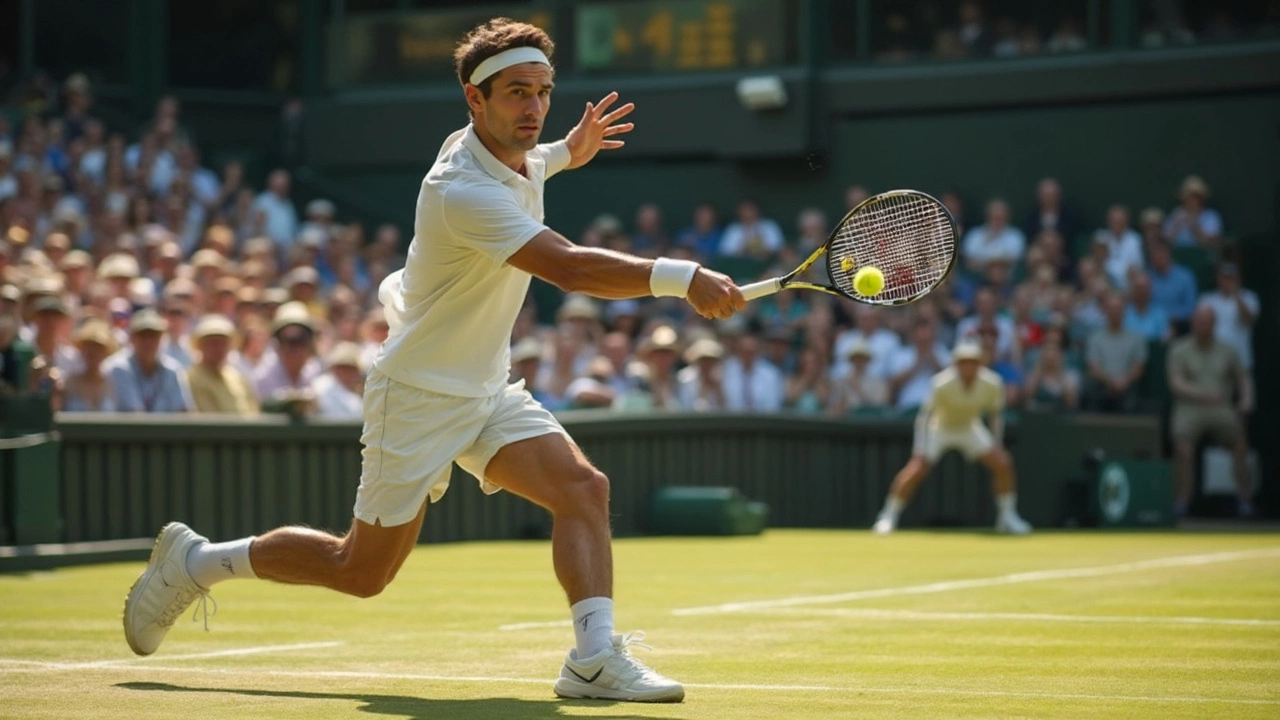7.0 Tennis Player: What Does It Really Mean?
 May, 8 2025
May, 8 2025
If you’ve spent any time around the tennis courts, you’ve probably heard people toss around numbers like 3.5, 4.0, or even 7.0 when talking about skill levels. That '7.0' sounds almost mythical—like the ultimate boss level. So what actually is a 7.0 tennis player, and why does it matter for tournaments?
The short version: a 7.0 tennis player is a world-class pro. We’re not just talking good, or even local tournament champion good. This is the level where players are playing in ATP or WTA events, trying to make it to the big stages like Wimbledon or the US Open. According to the official USTA (United States Tennis Association) rating system, '7.0' is reserved for those earning a living from tennis as a professional. No, your neighbor who takes weekly lessons and wins the club ladder isn’t a 7.0—unless his job is literally playing professional tennis.
This rating helps tournament organizers keep things fair. You can’t just let a casual weekend player face off against someone who’s played on TV. It wouldn’t be fun or helpful for anyone. So, if you’re curious where you fit, or hoping to climb the ranks, understanding this rating is your first step to picking the right tournaments and not getting smoked on court.
- What is a 7.0 Tennis Player?
- Understanding the Tennis Rating System
- What Makes a Player 7.0?
- Life as a 7.0 Player
- Tips for Leveling Up Your Game
What is a 7.0 Tennis Player?
If you want to know what sets a 7.0 tennis player apart from the crowd, it’s all about being a pro at the very top of their game. This rating is basically reserved for people who make their living from tennis—no exaggeration. Think Serena Williams, Novak Djokovic, or anyone who’s playing in Grand Slam events or top-level pro tournaments.
The USTA, who pretty much set the standard for tennis ratings in the U.S., says a 7.0 player is someone who “makes a living from tournament prize money.” In other words, this isn’t a weekend hobby. These are folks spending most of their days traveling for tournaments, practicing with elite coaches, and battling it out on the court against the world’s best.
“A 7.0 player is a world-class tournament professional.” — United States Tennis Association
You might be wondering how rare this is. According to recent stats, out of millions of players worldwide, only a tiny fraction even make it to the pro tour. Just cracking the ATP or WTA Top 1,000 puts you in this group, and the margin for error is razor-thin. Most 7.0s started playing tennis before elementary school and have been training like it’s a full-time job ever since.
| Level | Description |
|---|---|
| 6.5 | Highly ranked national amateur |
| 7.0 | Tour-level professional, makes a living from tennis |
For tournaments, this rating is important because it keeps matchups realistic. Let’s face it, you don’t want your local tennis league champ going up against someone who’s warming up next to Rafael Nadal during Grand Slam season. This keeps things fair and safe for everyone involved.
Understanding the Tennis Rating System
If you’re serious about tennis, you’ll hear terms like NTRP ratings tossed around at every tournament and club. The most common system in the U.S. is the National Tennis Rating Program (NTRP), created by the USTA. It sorts players from total beginners at 1.0 all the way up to top pros at 7.0. Each jump in number means a pretty big leap in skill level.
- 7.0 tennis player—a professional competing for prize money
- 6.0–6.5—players who compete nationally and internationally or were college standouts
- 5.0–5.5—high-level club or college players, usually playing at a competitive league or national level
- 4.0–4.5—solid, experienced club players who play in leagues and tournaments
- 3.0–3.5—casual players with reliable shots but still working on consistency
- 2.0–2.5—newer players learning the basics
These ratings aren’t just handed out randomly—they’re based on actual match results, how players perform against others of known levels, and sometimes self-assessments, especially for new players joining leagues.
Every year, the USTA recalculates ratings based on reported results from tournaments and league matches. This means people move up or down depending on how they stack up against their peers. Some clubs even add their own twist, right down to fun club ladder challenges. But if you want to play official USTA events, you'll need that NTRP number.
| NTRP Level | Skill Description |
|---|---|
| 3.0 | Hits ball consistently, still struggles with control |
| 4.0 | Confident with most shots, good rally player |
| 5.0 | Strong, strategic, plays at high-level tournaments |
| 6.5–7.0 | National-level to professional player |
This system makes finding fair matches way easier. Nobody wants to be steamrolled (or, honestly, do the steamrolling either). Know your level, and you’ll get more fun, challenging games every time you play.

What Makes a Player 7.0?
You don’t just walk onto your first tennis court and hit 7.0—not even close. Hitting this rating pretty much means you’re among the very best. The United States Tennis Association (USTA) defines a 7.0 player as someone who is “a world class player, typically playing in ATP or WTA events for a living.” In most cases, these are folks who’ve played at top college teams, gone through the pro circuit grind, or represented their country.
Here’s what sets them apart:
- 7.0 tennis player skill: These players know every shot in the book and can pull them off under intense pressure, even when thousands of fans are watching. Their technique holds up, whether it’s a rally lasting five shots or twenty.
- Endurance and speed: The physical side is next-level. We’re talking sprinting, sliding, diving, and recovering—over and over, sometimes for hours.
- Strategy: 7.0s read opponents like an open playbook. They make adjustments on the fly and never just hit balls without purpose.
- Mental toughness: Losing the first set or going down a break doesn’t rattle these players. They bounce back quickly—they have to, to survive on the circuit.
- Experience: Most 7.0s have played hundreds of official matches, often against ranked national or international opponents.
If you’re curious how rare this skill level is, check this out:
| USTA Rating | Description | Estimated % of Players |
|---|---|---|
| 3.0-4.0 | Recreational League | 75% |
| 4.5-5.5 | Competitive Amateurs | 20% |
| 6.0+ | Elite/Pro | <1% |
To put it simply, hitting 7.0 means you’re one of maybe a few hundred people in your entire country who can perform at this level. The path there requires not just talent and early training but also insane dedication. It’s not just about swinging hard or running fast—it’s about doing everything better, smarter, and more consistently than almost anyone else.
Life as a 7.0 Player
So, what does daily life actually look like for someone at the 7.0 tennis player level? The simple answer: tennis is their job, and it rules pretty much every hour. These players are hitting the courts almost every day—sometimes twice a day—plus doing gym work, strategy sessions, travel, and non-stop recovery work to avoid injuries. Forget casual weekends; their calendar is packed with tournaments, qualifying rounds, and constant travel.
If you check out stats from the Association of Tennis Professionals (ATP) or Women’s Tennis Association (WTA), pros average over 30 tournaments a year, moving between continents like it’s normal. And it isn’t just about showing up. Every match might mean a paycheque, a rankings boost, or a sponsor taking notice. At the top, the pressure is heavy because careers can change fast depending on results.
Here’s a breakdown of what a 7.0 player’s routine might look like in practice:
- Training: 5-6 hours a day on court plus at least an hour of physical training or therapy.
- Travel: Flying to different countries for tournaments is standard. You might wake up in Paris and sleep in Miami the next week.
- Matches: Opponents are all top-level athletes—there are no easy wins at this stage.
- Team: Most have coaches, fitness trainers, physios, and sometimes nutritionists.
- Recovery: Ice baths, massages, and constant attention to injuries—bodies have to hold up to a crazy schedule.
The money side isn’t always glamorous. While the top 10 players rake in millions, those ranked outside the top 100 are hustling for every tournament dollar and often cover their own travel and lodging.
| ATP/WTA Rank | Avg. Yearly Earnings (2023) |
|---|---|
| Top 10 | $4M+ |
| 50-100 | $400,000 - $1.2M |
| 100-300 | $80,000 - $400,000 |
If you were picturing a life of red carpets and endless luxury, it’s not really like that—except for maybe the top handful of names. For the vast majority of pros, it’s a grind. Pure talent only gets you so far. Determination, a rock-solid routine, and the ability to bounce back from setbacks are what keep 7.0 players in the game. My dog Max would definitely not put up with this travel schedule—just saying.

Tips for Leveling Up Your Game
If you’re shooting for anything close to the level of a 7.0 tennis player, you’ll need a serious plan. Let’s break down some tips that the best players actually follow—these are more than just the basics like "practice a lot."
- Quality Beats Quantity: Top players don’t just play for hours; they break their training into focused sessions. For example, they’ll spend 45 minutes on serves, then move to movement drills, rather than hitting around aimlessly all afternoon.
- Match Play Matters: Don’t avoid real matches because you’re nervous. Competitive match play is where you improve most. Some coaches even recommend playing two practice matches for every three drill sessions.
- Use Video Analysis: Pros constantly watch recordings of their matches and practice sessions to fix bad habits fast. You can do this with your phone. Watching yourself miss that easy volley is painful, but you’ll correct it quicker after you see it.
- Physical Fitness: At the highest levels, tennis is a grind. Even at amateur levels, increasing your endurance and reaction speed pays off. Studies show elite tennis players spend about 25% of their weekly training on strength and conditioning, not just hitting balls.
- Find a Coach (or Two): Even top pros swap coaches when they hit a wall. Don’t settle for just anyone—look for someone who’s worked with players at the next level above you.
Consistency is everything; small improvements add up. Track your unforced errors in matches, and set simple, measurable goals for your next session (like "fewer than five double faults" or "return 80% of first serves"). Here's a quick table on typical training splits for high-level players:
| Training Focus | Hours per Week |
|---|---|
| On-court Practice | 10-12 |
| Physical Conditioning | 5-7 |
| Match Play | 3-4 |
| Video/Strategy | 1-2 |
If these numbers look intense, remember: nobody jumps to the top overnight. The trick is steady progress, not epic leaps. Other than maybe Max chasing a ball, nothing in tennis gets great without putting in the work.